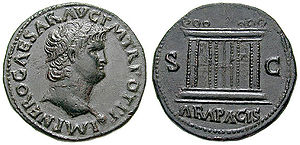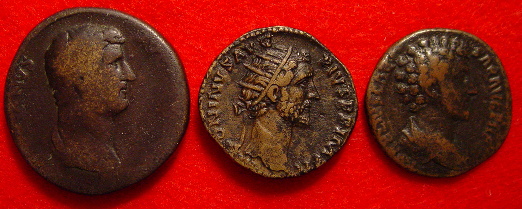.gif)
As (coin)
Encyclopedia

Greek language
Greek is an independent branch of the Indo-European family of languages. Native to the southern Balkans, it has the longest documented history of any Indo-European language, spanning 34 centuries of written records. Its writing system has been the Greek alphabet for the majority of its history;...
as , assarion) was a bronze
Bronze
Bronze is a metal alloy consisting primarily of copper, usually with tin as the main additive. It is hard and brittle, and it was particularly significant in antiquity, so much so that the Bronze Age was named after the metal...
, and later copper
Copper
Copper is a chemical element with the symbol Cu and atomic number 29. It is a ductile metal with very high thermal and electrical conductivity. Pure copper is soft and malleable; an exposed surface has a reddish-orange tarnish...
, coin
Coin
A coin is a piece of hard material that is standardized in weight, is produced in large quantities in order to facilitate trade, and primarily can be used as a legal tender token for commerce in the designated country, region, or territory....
used during the Roman Republic
Roman Republic
The Roman Republic was the period of the ancient Roman civilization where the government operated as a republic. It began with the overthrow of the Roman monarchy, traditionally dated around 508 BC, and its replacement by a government headed by two consuls, elected annually by the citizens and...
and Roman Empire
Roman Empire
The Roman Empire was the post-Republican period of the ancient Roman civilization, characterised by an autocratic form of government and large territorial holdings in Europe and around the Mediterranean....
.
Republican era coinage
The as was introduced in ca. 280 BC as a large cast bronze coin during the Roman Republic. In addition to the , fractions of the , the (2/3), (1/2), (5/12), (1/3), (1/4), (1/6), (1/12, also a common weight unit), and (1/24), as well as multiples of the as, the (2), (2.5), (3), (4), (5), and (10), were produced.
During the Republic, the as featured the bust of Janus
Janus (mythology)
In ancient Roman religion and mythology, Janus is the god of beginnings and transitions, thence also of gates, doors, doorways, endings and time. He is usually a two-faced god since he looks to the future and the past...
on the obverse, and the prow of a galley on the reverse. The as was originally produced on the libral
Libral
The libral standard compares the weight of coins to the bronze as, which originally weighed one Roman pound, but decreased over time to 1/2 pound , and further. It is often used in discussions of ancient coinage in Italy, especially Etruscan coins and Roman Republican coinage...
and then the reduced libral weight standard. The bronze coinage of the Republic switched from being cast to being struck as the weight decreased. During certain periods, no asses were produced at all.
Imperial era coinage

Numismatics
Numismatics is the study or collection of currency, including coins, tokens, paper money, and related objects. While numismatists are often characterized as students or collectors of coins, the discipline also includes the broader study of money and other payment media used to resolve debts and the...
as . The as continued to be produced until the 3rd century AD. It was the lowest valued coin regularly issued during the Roman Empire, with semis and being produced infrequently, and then not at all by the time of Marcus Aurelius. The last as seems to have been produced by Aurelian between 270-275 and at the beginning of the reign of Diocletian.
Byzantine coinage
The as, under its Greek name assarion, was re-established by the Emperor Andronikos II PalaiologosAndronikos II Palaiologos
Andronikos II Palaiologos , Latinized as Andronicus II Palaeologus, was Byzantine emperor from 1282 to 1328. He was the eldest surviving son of Michael VIII Palaiologos and Theodora Doukaina Vatatzina, grandniece of John III Doukas Vatatzes...
(r. 1282–1328) and minted in great quantities in the first half of the 14th century. It was a low-quality flat copper coin, weighing ca. 3–4 gram
Gram
The gram is a metric system unit of mass....
s and forming the lowest denomination of contemporary Byzantine coinage
Byzantine coinage
Byzantine currency, money used in the Eastern Roman Empire after the fall of the West, consisted of mainly two types of coins: the gold solidus and a variety of clearly valued bronze coins...
, being exchanged at 1:768 to the gold hyperpyron
Hyperpyron
The hyperpyron was a Byzantine coin in use in the latter Middle Ages, replacing the solidus as the Empire's gold coinage.The gold currency of the Byzantine Empire had been the solidus or nomisma, whose gold content had remained steady at 24 carats for seven centuries and was consequently...
. It appears that the designs on the assarion changed annually, hence they display great variations. The assarion was replaced in 1367 by two other copper denominations, the tournesion and the follaro.
Value in the market

Diocletian
Diocletian |latinized]] upon his accession to Diocletian . c. 22 December 244 – 3 December 311), was a Roman Emperor from 284 to 305....
in the third century AD:
- Farm laborer salary, with meals = 400 asses
- Elementary teacher's salary, per boy = 800 asses
- Barber's service price, per client = 32 asses
- 1 kg of pork = 380 asses (1 lb = 170 asses)
- 1 kg of grapes = 32 asses (1 lb = 15 asses)

